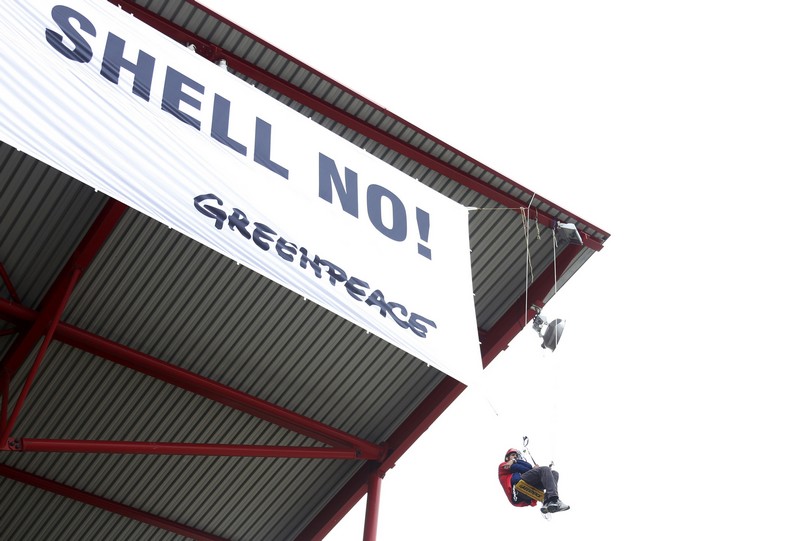Shell is one of the major spenders in Formula One, paying around US$30 million per year to sponsor Ferrari, with whom it has a contract up until the end of 2015 and, since 2011, investing a multi-million dollar sum with Formula One itself to title sponsor the Belgian Grand Prix. So it can't have been too impressed with the security arrangements at Spa-Francorchamps on Sunday, which allowed Greenpeace to infiltrate the grandstand and Shell-branded podium to protest at the company's arctic drilling activities.
'Arctic Oil? Shell No!' read a banner unfurled on the grandstand after Greenpeace micro gliders landed on the roof in the hour before the race. More banners, controlled remotely, were revealed on the podium as the national anthems rang out, reportedly having been placed there up to two weeks earlier. They were swiftly removed by Formula One's podium manager Alex Molina out of sight of the world feed television broadcast, which turned a blind eye. Hugh Mitchell, Shell International's chief human resources and corporate officer, presented the trophy to the winning constructor as planned.
'I can certainly respect the technology, sportsmanship and innovation that are at the heart of the Formula One Grand Prix,' wrote Kumi Naidoo, the executive director of Greenpeace in a blog post. 'But what I can’t respect is what the sponsor of the event, Shell, is doing to the Arctic.' An accompanying video of the podium ceremony, shot from the grandstand and later posted by Greenpeace, added: ‘Banner material: €50. Four car radio antennas: €88. Embarrassing Shell on its biggest PR day of the year? Priceless.
What next for Spa?
There will be arguments over the success or failure the protest, given the lack of TV impact, but this was the most serious security breach at a Grand Prix since Neil Horan, dressed as a priest, ran along the track at the 2003 British Grand Prix and the most notable against a sponsor of the sport since a disgruntled former Mercedes-Benz employee wandered along the side of the track at the 2000 German Grand Prix. Circuit officials from Spa-Francorchamps should, at the very least, expect a call from world motorsport's governing body, the FIA, an organisation which once banned Jerez from staging races following political interference in the podium ceremony in 1997. The Belgian Grand Prix has always walked a financial tightrope, despite being one of the most popular races amongst fans. With more venues than races seemingly available in the next couple of years – Russia on the horizon, a New Jersey race still not dead, Austria returning next year and Mexico City emerging over the weekend as a potential race host in 2014 or 2015 – it was the worst possible time to have failed to meet the sport's high venue standards.
Making an impact
When Ferrari-contracted Kamui Kobayashi crashed one of the team's Formula One cars during a demonstration event in Moscow last month, it might have been expected the team would try and brush the broken pieces under the carpet. Not a bit of it. Ferrari have made the most of it, releasing the on-board video of the shunt to the world. And Kobayashi himself – smiling perhaps through gritted teeth – returned to Moscow last week to present Eugene Kaspersky – the head of Ferrari sponsor Kaspersky Lab, which helped fund the demonstration – with the damaged nosecone from the accident. “It's an artifact manufactured in Italy and 'sketched' by a Japanese and now it has its best hanging here in Moscow,” said anti-virus software producer Kaspersky, whose logo was hardly touched amidst the damage. Kudos to Ferrari for making the most of an embarrassing moment.
The technicalities of the sport
While the world waiting for confirmation about who will partner Sebastian Vettel at Red Bull Racing next year, Formula One's technical merry-go-round has continued apace. Mercedes has this year added former McLaren technical chief Paddy Lowe to its ranks, joining Ross Brawn at the head of a team which at one stage last year had five former technical directors on its staff. At Ferrari, meanwhile, former Renault man James Allison has just begun work alongside Pat Fry, a former McLaren technical leader. Lowe has been replaced at McLaren by Tim Goss, who works closely with sporting director Sam Michael, a former Williams technical director. Michael was replaced at Williams by Mike Coughlan in 2011, but Coughlan has now been replaced by former Benetton, Renault and Marussia stalwart Pat Symonds. Symonds, whose first race in Williams colours was in Belgium, is only the fourth technical director in the British team's history after Patrick Head, Michael and Coughlin. All the changes are in preparation for the sweeping regulation changes coming into effect in 2014; this year, the big money moves are not just for the drivers.

